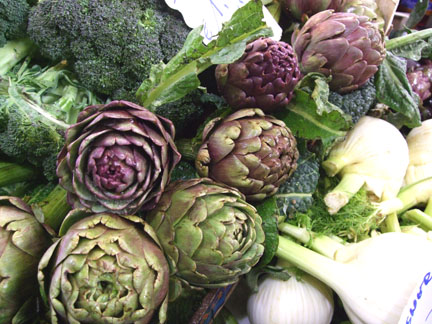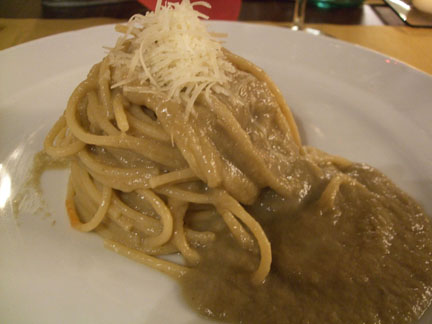
I may have to change the name of this blog from Artichoke Heart to Swiss Chard of My Heart (or something along those lines.) Lately I can’t get enough of this leafy green. That Swiss chard, cannellini bean, and barley soup should have kept me satisfied for at least a few weeks, but last weekend Jim and I returned for more, making a meatless lasagna layered with tomatoes, ricotta cheese, and yes, more chard.
The more I cook with Swiss chard, the more I realize how versatile it is. I first discovered it last summer when I made chard leaves stuffed with lemon rice, and since then I’ve tried to cook with it whenever possible. With its mild flavor—it’s not one of those bitter greens like escarole or broccoli rabe—and its sturdy, almost elastic texture, it holds its own in a variety of recipes. And as stated here and here by the New York Times, chard is one of the healthiest foods you could possibly eat, full of calcium, potassium, and vitamins C and A.
I should confess that I had never actually made lasagna before this past weekend. But with the help of this recipe, I got the hang of things quickly. I infused the tomato sauce with onions instead of garlic—I just happen to prefer my tomato sauces this way—and Jim and I used no-boil lasagna noodles. The result was wonderful: a light, healthy pasta dish where the sweet tomato sauce and ricotta cheese were perfectly complemented by the gentle chard. I’ll be honest, I didn’t miss the meat at all. I’m just trying to figure out what to make with the next batch of Swiss chard.
Recipe for Lasagna with Swiss Chard, Tomato Sauce, and Ricotta (Adapted from the New York Times’s Recipes for Health section. Tips on preparing no-boil lasagna noodles adapted from Cook’s Illustrated Magazine.)
- 1 large batch of Swiss chard, washed thoroughly
- salt
- 1/2 pound no-boil lasagna noodles
- Extra virgin olive oil
- 1 medium onion, chopped
- 1 28-ounce can of crushed tomatoes
- a pinch of sugar
- 5-6 leaves of basil
- freshly ground black pepper
- 1/2 cup fresh ricotta cheese
- 1/2 cup freshly grated Parmesan
Put a large pot of generously salted water over high heat. While you wait for the water to boil, make your tomato sauce. Add 1-2 tablespoons of olive oil to a medium saucepan over low heat. Add the chopped onion to the pot and cook, stirring, until soft. This should take about 5 minutes. Remove the onions from the oil and discard. Add the tomatoes, sugar, basil, and a pinch of salt and bring to a simmer. Stir often, until the sauce thickens, about 30 to 40 minutes. When finished, remove the basil leaves and discard. Set the pot to the side and turn to the Swiss chard.
Fill a bowl with ice water. Cut the Swiss chard leaves away from the stems. Discard the stems or save them for another use. When the water in the large pot is boiling, add the Swiss chard. Boil for 1 minute (from the time the water comes back to a boil). You want the leaves to be tender but still bright green; do not overcook. Remove the leaves from the water with a slotted spoon and add them to the ice water; this stops them from cooking further. Drain and squeeze out excess water. Chop the leaves coarsely. Put the tomato sauce back over low heat, stir in the Swiss chard, and set the pot aside again.
Prepare the lasagna noodles. Fill an oblong baking dish with hot tap water. Add the noodles and soak for 10 minutes, shaking the dish often to keep the noodles from sticking together. Remove the noodles to clean dishcloths and dab excess water.
Preheat the oven to 375 degrees. Add a thin layer of tomato sauce to the bottom of a rectangular baking dish. Add a layer of lasagna noodles. Spread half the ricotta over the noodles and half the tomato-chard sauce over the ricotta. Sprinkle 2 tablespoons of Parmesan over the tomato-chard sauce. Add another layer of noodles and top them with the rest of the ricotta, sauce, and 2 tablespoons of Parmesan. Finish with a layer of noodles and the remaining Parmesan. Drizzle 1 tablespoon of olive oil over the top of the lasagna. Cover tightly with foil. Bake for 30 minutes. If you like, finish the lasagna under the broiler for 3 minutes, uncovered, until top is browned. Let the lasagna rest for 5 minutes. Serves 4. Enjoy!








 Subscribe to the Choke
Subscribe to the Choke 
